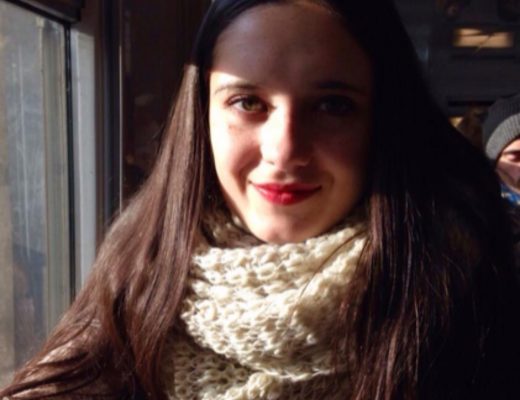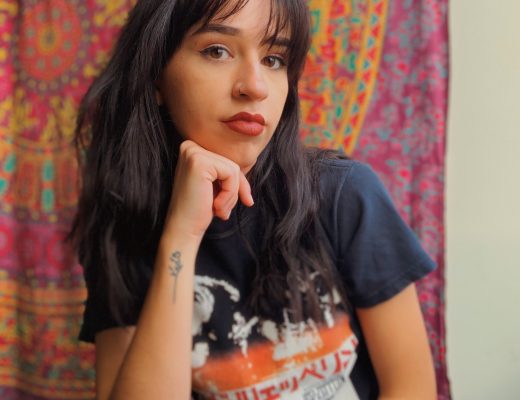Naked
 The Polaroids arrived in a padded envelope marked “CONFIDENTIAL.” After thirty-five years, my ex-husband had returned photos he took of me during the first year of our brief marriage. I was twenty-one years old at the time, and I was naked.
The Polaroids arrived in a padded envelope marked “CONFIDENTIAL.” After thirty-five years, my ex-husband had returned photos he took of me during the first year of our brief marriage. I was twenty-one years old at the time, and I was naked.
We hadn’t spoken since our divorce, my ex and I, but a mutual friend interceded. “He came across these nude pictures of you when he was moving,” she said. “They were—and these were his words—‘studies’ for a painting.”
I had no memory of posing nude for any “studies” and only faintly remember our blip of a marriage. “Tell him to toss them,” I said.
“You sure?”
I imagined the trash bag breaking and the Polaroids, flecked with coffee grounds, strewn across the sidewalk and discovered by a stranger. (You laugh, but I once found—right in the middle of my street—a trove of elicit email correspondence between my neighbor and her secret online lover, so it can happen.) Also, I was curious. “Give him my address.”
But when the package arrived a week later, seeing my name written in his pudgy, uneven capital letters tempered my curiosity. That I still recognized his handwriting, that the sight of it startled me—these were warning signs, like CAUTION WHEN OPENING. CONTENTS UNDER PRESSURE. I slid the package into a tower of papers I ridiculously call my “In Box” and went about my business.
I lead an active life. I have writing deadlines and fundraising functions and yoga and computer Solitaire. I have R. We have been married for twenty-five years. His work is intense—higher ed. Administration, The “dark side of academia” he used to say in his professorial years. Our days hum, measures of ritual and obligation and pleasure, a constant shifting of gears to accommodate the (expected) unexpected, both crisis and joy. Our tempo makes it easy to avoid the uncomfortable until it becomes the inevitable.
For two weeks, the package lay unopened. One night, when R was away on business, and I had drunk just enough wine to feel plucky, I dug out the envelope and opened it.
There I was, standing naked on a coffee table.
The reverberation of memory knocked me for a loop. I riffled through the photos, cheeks warm, palms damp, heart beating like a kettledrum. I went through them again, slowly. The experience felt intimate and awkward, like talking to a former lover at a party with your husband at your side.
I counted nine, taken in two sessions judging from my different hairstyles. In one shot I stand with arms raised, elbows bent, forming a kind of tent over my tilted head. My expression reads somewhere between pensive and pouting. My legs are squeezed together, one knee cocked, like I’m self-conscious of the dark cusp between my thighs. In one particularly absurd shot, I arch my back and spread my arms like I’m flying (surely not my idea). In yet another, I recline on our bed against a cushion covered in Indian paisley, an arm draped across my torso, my fingers grazing my tan line. The pose struck me as a hazy imitation of Edouard Manet’s famous painting Olympia. I remembered studying the painting in an art history class, not too long before these photos were taken. Was that the look I was going for?
Later, I told R. about the photos. I was making dinner; he was making cocktails. “Oh, yeah?” he says. “And?”
I have learned over the years that this is his way of saying, and how does that make you feel?
I shrugged. “I’m still processing.”
“At least you didn’t have Facebook back then.” He handed me a margarita.
I thought about the torn trash bag, a stranger’s eyes, my neighbor’s email. “That’s a comfort.” I took a hefty swallow and relished its burn. R. makes a killer margarita.
Most of the time, I read my body like a product, each wrinkle, sag, and dark spot a warning label. I was really asking for it, standing naked in front of my big bathroom mirror taking in my sixty-one-year-old body. But I had been working on an attitude of nonjudgment. I saw that my shoulders are now more angular, waist thicker. My chest is a freaking topographical map. I leaned toward the mirror: blue capillaries run like rivulets across a landscape of pinks and browns; a trident of cherry red dots inscribes one breast. The seam of a scar cuts a borderline beneath my belly. And the effect of gravity: one needs no greater proof of the weight of the world than the aging body.
Yet here’s the thing: I did not despair. In fact, I was awestruck by this corporeal sculpture reflected in my mirror, wrinkles, age spots, and all. My body was fucking remarkable.
Let’s return to Olympia. In Manet’s late nineteenth-century painting, a courtesan reclines against voluminous white pillows, naked save for a single gold slipper, its mate nestled in a floral shawl. Her direct gaze—enigmatic, unabashed—beckons the viewer into her world. No allegorical setting, no cherubs or gods romanticize the scene. Viewers at the time couldn’t escape their own complicity. I see you, the courtesan seems to say, as if you were here. Indeed! Manet may have imagined the scene, but the scenario must have been all too familiar to wealthy Parisian men. The work so scandalized Parisian audiences that it had to be hung higher than a dagger’s reach.
It wasn’t the flesh that outraged; it was the eyes. That cool gaze resists judgment, scorn, objectification.
I returned to the Polaroids. In each one, I look anywhere but at the camera and my ex-husband behind it. Maybe at a dusty baseboard, a seam of cracked plaster, a sad curtain I wish I could stand behind. Did I feel at the time as awkward as I look? I don’t remember. But now these images seemed to frame my own projections, self-judgment, and my shame. I struggled with the gradual recognition of that version of myself: the girl trying to be the girl who was not the girl I really was.
I met my ex-husband during my junior year in college. He was four years older than I. He played guitar and made art. He had pool-blue eyes and corn silk hair that fell past his shoulder blades. His construction job was only temporary, he said, just to pay the rent, just until his art began to sell. I loved how he could place himself in a future that he seemed to know how to craft. It took just weeks for me to see myself in it. He exuded a creative spirit that sparked my own, but, unlike me, he seemed supremely confident in just about everything he did or said. I, on the other hand, was idealistic but filled with self-doubt and apprehension about my future. I had grown up in a small town during the 60s in a conventionally dysfunctional family; my father was an office manager, my mother—after we kids were in high school—worked part-time as a secretary. All the women I most admired were teachers. They all had encouraged my writing, but no one told me how to make a living at it. So, I took the education courses required to teach high school English. When my ex and I married, I had only to complete a full-time internship in order to graduate. Despite my college success (summa cum laude!), my mastery of education theory (bring on the open classroom!), my creative lesson plans (A+!), I was terrified of failing.
My ex varnished over my fear with his adoration. He courted me with love songs and visions of a beautiful bohemian future in which I would teach and write, he would paint, and our rent would be paid by magic.
We met in the spring, and by September we were married. I moved out of my cute walk-up apartment in a remodeled Victorian to his apartment, one of about six odd configurations carved out of a large white neoclassical house that once would have been called stately. It was now an incubator for roaches and mice, its halls a litter box for every stray cat that wandered in off the street. Almost immediately, the problems began.
My internship—teaching ninth grade English in a school attended almost entirely by kids from the poorest neighborhoods in the county—was a daily struggle. Robert blamed the “radical” pedagogies I had been taught (damn the open classroom!). I tried to convince myself that our arguments were only “philosophical disagreements,” yet every criticism felt personal and gnawed at what little confidence I had left. When my internship ended, I got a job as a cocktail waitress.
Then there was money, cliché but true. Only after we were married did I learn of my ex-husband’s considerable debt and taste for expensive pastimes. A van. A handgun. Valium. By working at night, I thought I could write during the day. But every minute I sat at the typewriter I felt I should be somewhere else, doing something more productive, more lucrative.
The self-confidence that I had once found so attractive in this man now played like an intractable insistence on his own authority. When I learned of his affair with another waitress from the same bar where I worked, I was so worn down that I believed it was my fault.
That’s the girl I saw in those Polaroids.
Maybe I had been flattered to serve as my ex-husband’s “model.” Maybe he made me feel special enough to wash over my self-doubt and unhappiness, at least for a time. I was not content to be the muse, but I settled for it, sublimating my own creative impulses to feed his, allowing my life, like my limbs, to be arranged by someone else.
The marriage lasted less than three years, the self-sabotage much longer.
After we divorced, I bounced around like random particles, attaching myself to a series of men to feel solid, identifiable. Eventually, I found my way to graduate school and back to writing. I was still terrified but soon learned that every writer I knew was afraid, whether of facing the blank page or filling it with dreck. I began to take small risks without the soul-crushing expectation of failing and felt reckless with relief when I succeeded.
I met my husband during one of those reckless highs. What began as an irresponsible fling became a partnership—creative, intellectual, romantic, exasperating. Our relationship sometimes seems remarkable for its longevity and at other times inevitable.
Still. Even purpose, confidence, and love can’t completely silence the self-defeating harpy that has nagged me all my adult life.
In the early years of our relationship, I used to ask R.: what do you love about me? I wanted a list. I thought if I just knew what attributes he loved in me, I could perfect them, like public speaking skills. He never bit. Sometimes, though, when we were going through a rough patch, he would say, “You’re the most interesting person I know.” This is one reason I love him; he gives me the thing I really need when I think I need something completely different.
I asked him if he wanted to see the pictures. I knew what he’d say, but I’m trying to be up front. He has his own demons. Over the years we have wrangled with them—and with mine—together and separately. We have seen each other naked almost every day for three decades.
It’s taken years of therapy and vigilance to come to terms with my self-doubt and learn to recognize the patterns of behavior I fall into: the raised voice that silences mine, the desire for approval, the passive aggression, the pointless secrets. I’ve had to acknowledge, finally, my lost chances. It pains me to think about the risks I avoided and the choices I made based on the stories I had constructed about who I was—and was not. The naked girl in the Polaroids reminds me of that cost.
I thought about burning the pictures. I imagined the images dissolving, the naked, needy girl consumed in a ritual fire. Instead, I tucked her in the back of a desk drawer, the one with the fifteen floppy discs, the three-hole punch, the business cards from four previous jobs—stuff that I know I don’t need and will throw away, eventually.
In a career spanning more than twenty-five years, Robyn Allers has written for print, video, and digital formats for magazines, newspapers, and corporate and nonprofit clients. She earned an MA from Florida State University. Her fiction has appeared in Apalachee Quarterly, The Southeast Review, Crosscurrents, and Belles’ Letters, an anthology. She has also run a college art museum for a time, taught writing and theater, and has traveled to a hundred countries. Currently, she lives and writes near Baltimore, Maryland.


